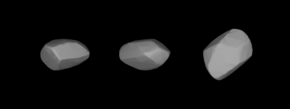 A three-dimensional model of 152 Atala based on its light curve. A three-dimensional model of 152 Atala based on its light curve. | |
| Discovery | |
|---|---|
| Discovered by | P. P. Henry |
| Discovery date | 2 November 1875 |
| Designations | |
| MPC designation | (152) Atala |
| Pronunciation | /əˈtɑːlə/ French: [atala] |
| Named after | Atala |
| Alternative designations | A875 VB |
| Minor planet category | Main belt |
| Orbital characteristics | |
| Epoch 31 July 2016 (JD 2457600.5) | |
| Uncertainty parameter 0 | |
| Observation arc | 130.69 yr (47735 d) |
| Aphelion | 3.3855 AU (506.46 Gm) |
| Perihelion | 2.8984 AU (433.59 Gm) |
| Semi-major axis | 3.1420 AU (470.04 Gm) |
| Eccentricity | 0.077507 |
| Orbital period (sidereal) | 5.57 yr (2034.2 d) |
| Mean anomaly | 52.593° |
| Mean motion | 0° 10 37.092 / day |
| Inclination | 12.114° |
| Longitude of ascending node | 39.945° |
| Argument of perihelion | 59.807° |
| Earth MOID | 1.93567 AU (289.572 Gm) |
| Jupiter MOID | 1.85235 AU (277.108 Gm) |
| TJupiter | 3.171 |
| Physical characteristics | |
| Dimensions | 65 ± 8 km 71–122 km |
| Mass | (5.43 ± 1.24) × 10 kg |
| Synodic rotation period | 6.246 h (0.2603 d) |
| Sidereal rotation period | 5.28-6.25 hours |
| Geometric albedo | 0.054 |
| Spectral type | D |
| Absolute magnitude (H) | 8.33 |
152 Atala is a large main belt asteroid that was discovered by brothers Paul Henry and Prosper Henry on 2 November 1875, but the discovery was credited to Paul. It is a type D asteroid, meaning that it is composed of carbon, organic rich silicates and possibly water ice.
The asteroid is named for the eponymous heroine of the 1801 novella Atala by François-René de Chateaubriand. The Henry brothers also named the last of their discoveries, 186 Celuta, after another Chateaubriand heroine. Both Atala and Céluta are American Indian fictional characters.
An occultation of a star by Atala was observed from Japan on 11 March 1994. Subsequent occultations have been observed as recently as 2006.
Photometric of this asteroid made in 1981 gave a light curve with a period of 5.282 ± 0.004 hours with a brightness variation of 0.50 in magnitude.
References
- Hardard's Numbered MPs
- "The Asteroid Orbital Elements Database". astorb. Lowell Observatory.
- Yeomans, Donald K., "152 Atala", JPL Small-Body Database Browser, NASA Jet Propulsion Laboratory, retrieved 12 May 2016.
- Ďurech, Josef; Kaasalainen, Mikko; Herald, David; Dunham, David; Timerson, Brad; Hanuš, Josef; et al. (2011). "Combining asteroid models derived by lightcurve inversion with asteroidal occultation silhouettes" (PDF). Icarus. 214 (2): 652–670. arXiv:1104.4227. Bibcode:2011Icar..214..652D. doi:10.1016/j.icarus.2011.03.016. Archived from the original (PDF) on 3 March 2016. Retrieved 26 January 2012.
- Asterodoccultation.com Archived 2006-10-10 at the Wayback Machine
- Carry, B. (December 2012), "Density of asteroids", Planetary and Space Science, vol. 73, pp. 98–118, arXiv:1203.4336, Bibcode:2012P&SS...73...98C, doi:10.1016/j.pss.2012.03.009. See Table 1.
- SPIFF LCSUMPUB
- Schmadel, Lutz D.; International Astronomical Union (2003). Dictionary of minor planet names. Berlin; New York: Springer-Verlag. p. 29. ISBN 978-3-540-00238-3.
- Schmadel, Lutz D.; International Astronomical Union (2012). Dictionary of minor planet names (6th ed.). Berlin; New York: Springer-Verlag. p. 29. ISBN 9783642297182. Retrieved 4 April 2014.
- Chateaubriand, François-René (1801). Atala.; Chateaubriand, François-René (1802). René.
- Schober, H. J. (July 1983), "The large C-type asteroids 146 Lucina and 410 Chloris, and the small S-type asteroids 152 Atala and 631 Philippina - Rotation periods and lightcurves", Astronomy and Astrophysics Supplement Series, 53: 71–75, Bibcode:1983A&AS...53...71S.
External links
- Occultation of TYC 5558-01048-1 by (152) Atala on 2006 May 7 UT
- (152) Atala near opposition 5 July 2007 (2.38AU from Earth)
- 152 Atala at AstDyS-2, Asteroids—Dynamic Site
- 152 Atala at the JPL Small-Body Database

| Minor planets navigator | |
|---|---|
| Small Solar System bodies | |||||||
|---|---|---|---|---|---|---|---|
| Minor planets |
| ||||||
| Comets | |||||||
| Other | |||||||
This article about an asteroid native to the asteroid belt is a stub. You can help Misplaced Pages by expanding it. |
- Minor planet object articles (numbered)
- Background asteroids
- Discoveries by Paul Henry and Prosper Henry
- Named minor planets
- Objects observed by stellar occultation
- I-type asteroids (Tholen)
- S-type asteroids (SMASS)
- Astronomical objects discovered in 1875
- François-René de Chateaubriand
- Main-belt-asteroid stubs